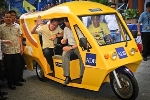Plug-in electric vehicles may just be entering the market, but most U.S. consumers are ready to buy them.

Green Mountain Energy Co. has launched a widely available, emissions-free Texas wind-powered product designed for drivers of plug-in electric and plug-in hybrid electric vehicles.
Researchers in America have shown that ozone can be reduced, on average, when electric vehicle charging is done at night time.

Philippines mark an important first step towards a sustainable, energy-efficient transport model with electric tricycles.
Developed in cooperation with BMW, this non-contact technology also works if drivers only make a short stop to recharge.
Siemens has launched a new electric-vehicle charging station on the market that can fully recharge a battery within one hour. By doubling the output to 22 kilowatts, the charging station cuts charging times in half.
Two reports from Citi and Ceres predict U.S. car manufacturers will see greater sales than their global competitors.
With the ChargeCar Project, Carnegie Mellon intends to show that gas-powered cars can be converted successfully into electrically powered commuter vehicles and to develop a network of local mechanics who can perform these conversions.
Using ammonia borane, researchers were able to reuse "spent fuel" for possible application in storing hydrogen on vehicles.

Hyundai, Nissan, and Toyota use their electric vehicle purchasing power and experience in more than cars.
Ford's eco-friendly driving technologies coach drivers to more fuel-efficient driving habits, using real-time feedback and rewards.
The C-ZEN, powered by lithium phosphate batteries, has a range of 125 miles and a top speed of 68 mph.
An electric tour company now offers an historical tour of Golden Gate Park in San Francisco.
As the price for a gallon of gasoline creeps over $4.00/gallon – and shows no sign of slowing – many drivers are wondering if they should trade in their gas guzzler for something more fuel efficient, such as a hybrid or electric vehicle. According to the editors at Cars.com, the answer is most often "No."
AAA released its biennial list of top picks for new vehicle technology. Developed by automotive experts at the nation's largest motor club, the list features a variety of interesting vehicle technologies intended to improve safety, increase performance and reduce the environmental impact of some of the newest models on the market.
A pioneering program by one of the world's largest cities to switch its vehicle fleet to clean fuel has not significantly improved harmful vehicle emissions in more than 5,000 vehicles – and worsened some vehicles' climate impacts.
James Brazell spent 40 years working for Texaco, ultimately retiring from the oil company as the coordinator of its worldwide exploration and production activities. So what is he doing driving a Crystal Red Chevrolet Volt electric car?
The U.S. Department of Energy’s National Renewable Energy Laboratory recently completed a year-long technology evaluation of gasoline hybrid electric trucks compared with conventional diesel vehicles.
Kia Motor Corp. has signed a memorandum of understanding (MOU) with members of the Clean Energy Partnership (CEP) to help promote Fuel Cell Electric Vehicles (FCEV) and showcase the company's competitiveness in eco-friendly vehicles. The initial agreement was signed yesterday in Seoul, attended by Dr. Hyun Soon Lee, Vice Chairman and head of Hyundai-Kia R&D; Dr. Klaus Bonhoff, Managing Director of NOW GmbH (National Organization of Hydrogen and Fuel Cell Technology); Patrick Schnell, Chairman of the Clean Energy Partnership (CEP) and other CEP members. As part of its global activities to prepare commercialization of fuel cell vehicles, Kia intends to join the Clean Energy Partnership in 2011. The parties agreed to negotiate respective terms for participation.

The company now offers its most popular high-performance electric bikes: The Fighter and the Bomber.